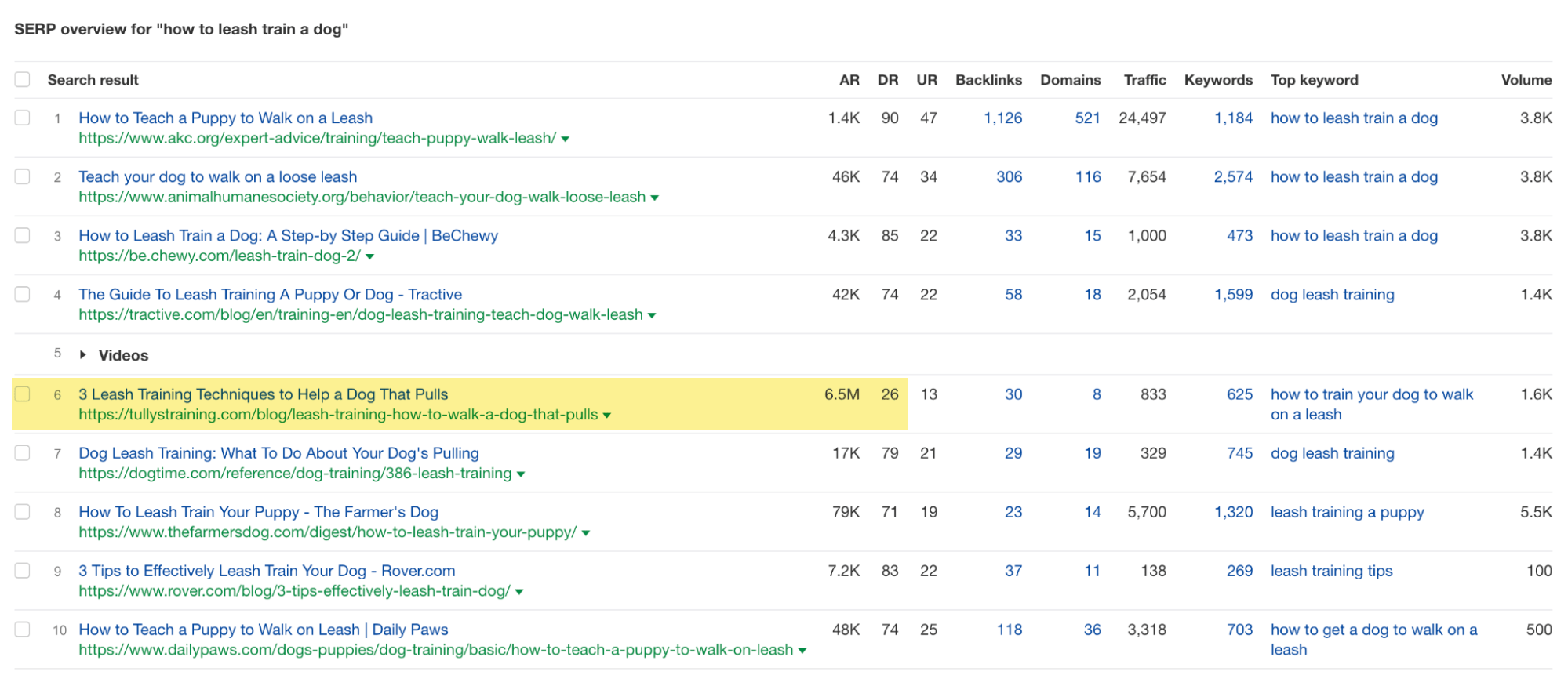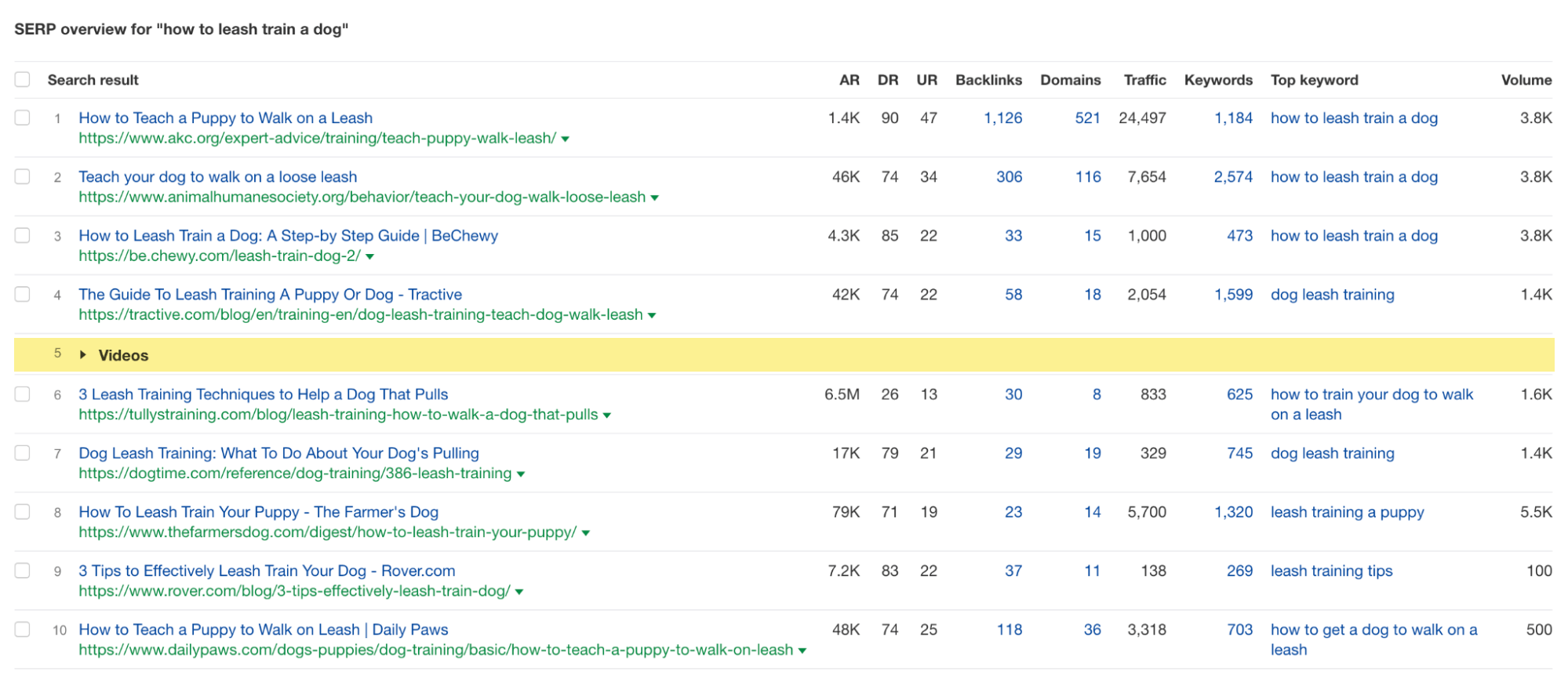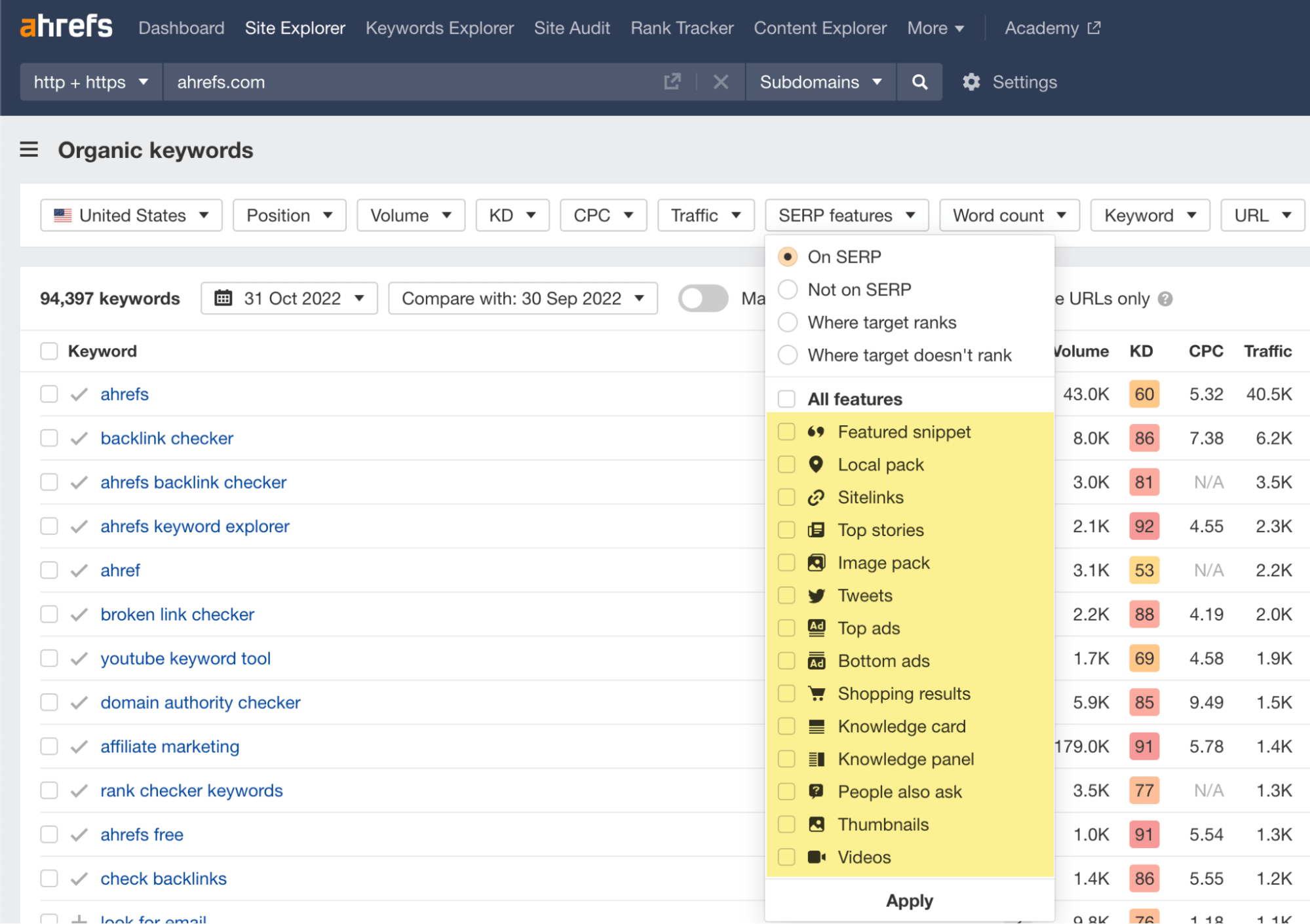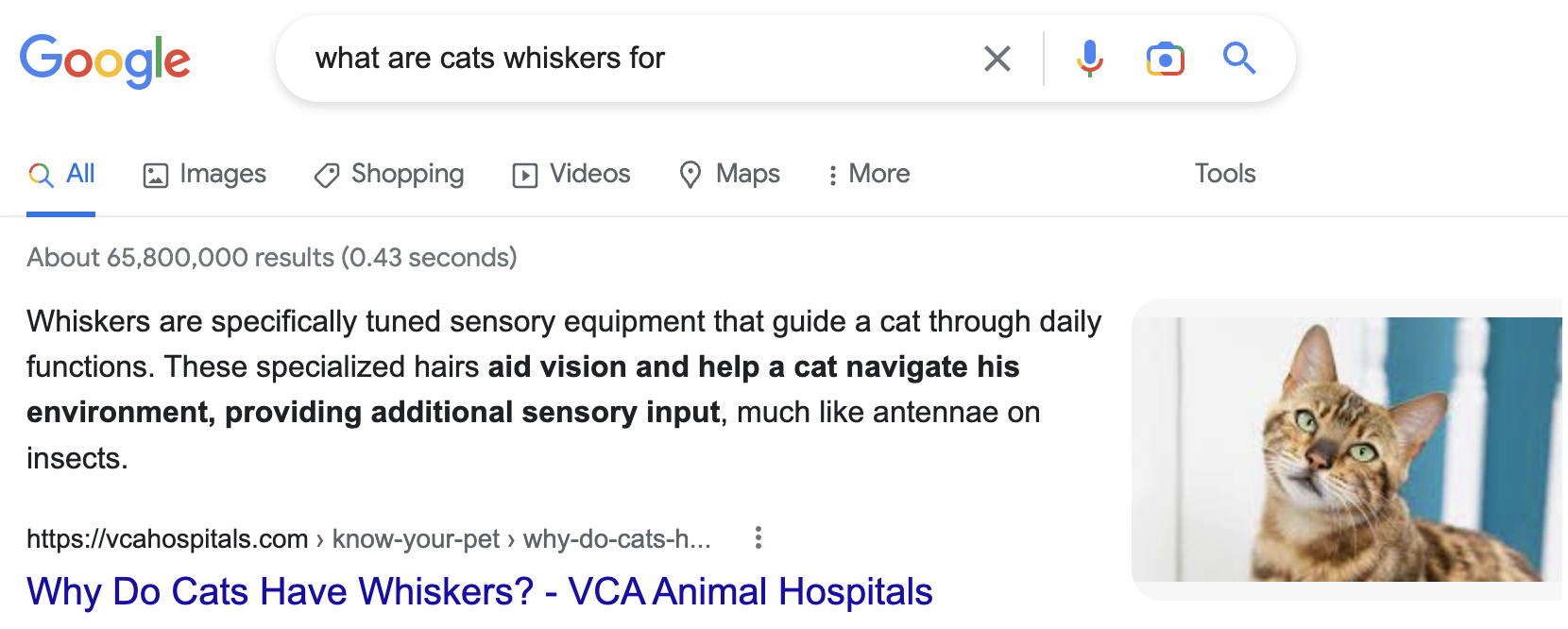It’s important because not all keywords are created equal. Some are harder to rank for than others, so you must choose wisely.
In this guide, you’ll learn how to analyze a SERP to see if it’s crackable.
Let’s get started.
The first step of a SERP analysis is to get a rough sense of the traffic opportunity and ranking difficulty opportunity.
To do this, we can use two of Ahrefs’ core metrics: Keyword Difficulty and Traffic Potential.
- Keyword Difficulty (KD) estimates how hard it will be to rank on the first page of Google for a keyword on a scale from 0 to 100.
- Traffic Potential (TP) is the total estimated monthly search traffic to the top-ranking page for a keyword.
Using these two metrics, we will be able to get a top-level overview of the SERP and determine whether it’s worth further investigation.
Let’s use Ahrefs’ Keywords Explorer to get a quick, high-level view of the keyword “when were dogs domesticated.”

So what exactly is the overview showing us?
We can see the keyword “when were dogs domesticated” has a super hard KD of 73 but a low TP of 3.2K.
At first glance, this query doesn’t appear to be worth the effort. But it may warrant further investigation if this topic is lucrative for your business.
With a super hard KD of 73, Ahrefs estimates that we will need ~235 links to rank in the top 10 for this SERP, which will require a fair amount of resources to compete.
Generally speaking, it is better to look for low-KD and high-TP queries, where possible.
To better understand the effort-to-reward ratio for this query, and any others, we can plot the effort-to-reward ratio in an XY graph:

- Top left: Golden opportunities (low investment, high reward).
- Top right: Long-term opportunities (high investment, high reward).
- Bottom left: Possible opportunities (low rewards, so effort might not be worth it).
- Bottom right: Try to avoid (unless it’s a highly lucrative topic for your business).
Our query for “when were dogs domesticated” falls into the “high effort, low reward” quadrant, so it may not be worth the effort.
We are looking for a query that falls in the top left-hand section. In most cases, these will be the golden keyword opportunities.
Avoid queries that fall into the bottom right section where possible unless it is particularly lucrative for your business.
Let’s try to find a search with more opportunity.
Let’s plug in “how to leash train a dog” into Ahrefs’ Keywords Explorer and see if this keyword has better metrics.

We can see that this query has a medium KD of 18 but a much higher TP of 24K. Great!
We can see that this search has a much better effort-to-reward ratio than our previous query, so let’s scroll down the page in Keywords Explorer to the SERP overview and investigate if (and how) we can rank.
Now that we have completed our top-level overview, we can consider other factors using the SERP overview in Ahrefs’ Keywords Explorer.
We should consider four key elements in our SERP analysis when investigating the ranking difficulty:
1. Domain Rating (DR)
DR is one of Ahrefs’ most widely used metrics in SEO. It shows the relative strength of a website’s backlink profile on a scale from 0 to 100.
It’s not a Google ranking factor, but there are a couple of reasons why it can be easier for high-DR sites to rank on Google:
- They can boost a page’s strength with internal links – High-DR sites have lots of strong pages. They can funnel some of this strength to specific pages with internal links.
- They are often trusted brands – People may prefer to click these results on the SERPs. They may also have more topical authority, which may help.
These reasons explain why 64.9% of SEOs pay attention to DR when analyzing their chances to rank:
While it’s certainly possible to outrank a higher DR site, a good rule of thumb is to look for pages ranking in the top 10 with the same DR as you or lower. By doing this, we can maximize our chances of appearing on the SERP.
If we return to our previous query “how to leash train a dog” and look at the SERP overview, we can see that the first result comes from a DR 90 site.
Even with a high-DR site, this looks hard to beat.

- Scanning down the DR column, we can see that 8 out of 10 sites have a DR of 70+, so we could potentially be on the back foot from the start with this query.
- Jumping to the sixth result, we can see that it has a DR of 26, which suggests that this SERP is crackable, at least in terms of DR.

Finding outliers like this DR 26 site is what we need to be focusing on at this stage. It can mean that ranking on this SERP with a ≤ 70 DR site is possible.
Assuming that we don’t have a DR 70+ site, our hopes of ranking will most likely rest on equalling the ranking of the DR 26 site.
It is worth noting that the traffic this site receives is estimated to be around 833, which is a lot lower than our original estimated 24K TP.
With these revised figures, we need to reevaluate whether the effort is worth the reward at this stage. That depends on our website’s authority, our risk appetite, and the resources available.
Although DR plays an important initial role in our SERP analysis, there are other factors that we should consider as well, such as links.
2. Links
If you ask an SEO what the top Google ranking factors are, chances are they will mention “backlinks” in their reply.
But what exactly is a backlink? Simply put, backlinks are clickable links from one website to another.

Backlinks are also highly important for ranking on Google, as they are one of eight confirmed ranking factors.
We saw in step #1 that KD can give us a broad indication of how many links we will need to rank, but actual link numbers will vary from site to site.
Let’s return to our query for “how to leash train a dog” in the SERP overview and take a closer look at the links.

- Looking at the Domains column in the above image, we can see that the first result has 521 referring domains. Unless we can acquire over 521 referring domains, we should rule out the possibility of outranking this result.
- The second result has 116 domains. Again, this seems relatively high, so we should probably rule out outranking this result too.
- Positions #3–10, however, have ≤ 36 domains each, which is where the most opportunities lie on this SERP.
We can see from this link analysis that the lower end of the SERP is much easier to crack—at least in terms of links.
If we hone in on the sixth result, we can see that this site only has eight domains.

Acquiring more than eight domains should be achievable for most businesses, so this could be a great opportunity.
We only need to be aware that the estimated traffic for the sixth result is much lower than our initial TP estimate of 24K and is now 851.
Looking at the rest of the SERP’s traffic, we can see that rather than gradually declining, the eighth and 10th results have more impressive estimated traffic, 5,895 and 3,643, respectively.
This may mean that the estimated traffic opportunity may not be as low as 851, but it can vary depending on our exact position.
So far, just using DR and links, we have seen how feasible it will be for us to rank on this SERP. We can see that the lower half of the SERP (from positions #6–10) is most achievable at this stage.
Now we will need to consider the role of search intent on the SERP.
3. Search intent
Search intent is used to describe the primary reason for an online search. In other words, it indicates why the user typed their query into the search engine in the first place.
But what does search intent mean in terms of our SERP analysis?
In a nutshell: Our webpage needs to provide the best answer for the query to rank well on the SERP. Identifying the dominant search intent on the SERP can help determine how or if we will compete.
Most content on the internet falls into the categories below and, for our SERP analysis, it makes sense to use this categorization:
- Blog posts
- Category pages
- Product pages
- Landing pages
- Videos
Let’s use Ahrefs’ own keywords to explore this concept in more detail.
Say we have a website that we want to rank for “backlink checker,” and we have written a blog post targeting that query.
This alone will not enable us to rank for this query, as the intent of this search is strongly aligned toward SEO tool companies with big backlink databases—like Ahrefs. For these types of websites, the backlink checker is likely to be one of their main product pages.
If you thought of it, why would you click on a result for “backlink checker” that didn’t have a backlink checker product?
You probably wouldn’t.
This rules out the possibility of targeting this keyword for the average website creating a simple blog post on this topic.
Let’s consider another more visual example using Ahrefs’ Keywords Explorer. Let’s plug in the keyword “how to draw a picasso face” and scroll down to the SERP overview.
With this query, we can see that 4 out of the top 6 results on this SERP are video-based. Therefore, we can see that the search intent is focused on video content.

Because this format of content is so dominant at the top of the SERP, it will likely be tough to rank near the top of this SERP unless we create video content ourselves.
Returning to the SERP overview for our “how to leash train a dog” search query, we can see that the majority of the articles here are blog posts, but the fifth result is a video SERP feature.
This indicates that, at least for some searches, searchers are looking for video guides rather than blog posts about this topic.

With this type of mixed search intent, it is best to create content in both formats, assuming you have the expertise and resources to compete. This will likely increase the chances of appearing on the SERP for this particular keyword.
In summary, we have seen how analyzing search intent can help inform our SERP strategy and determine if and how we will compete.
Let’s now take a look at content quality.
4. Content quality
It’s worth being aware that the standard of content Google expects can be much higher for certain topics.
For example, in a Your Money or Your Life (YMYL) topic, such as medical advice, you likely need to provide content created or reviewed by doctors to compete on the SERP.
Google defines YMYL topics as the following:

Unless you have the resources to compete on these types of SERPs, then it is a good idea to stay clear of them.
Even in non-YMYL topics, such as product reviews, there are sites like Wirecutter independently reviewing thousands of products every year with great success. So it’s not just YMYL topics that have extremely high-quality content.

Wirecutter now has the backing of The New York Times, so it has tremendous resources at hand.
Looking at its website, it typically updates or publishes around 10 articles per day, and this is despite its reviews taking “weeks or months of research” to complete.
So how do high-quality sites like Wirecutter impact our SERP analysis?
Simply put, if there is a website that has high-quality content within the SERP, then you should consider whether you have the resources to compete and outrank them.
The final step of our SERP analysis is to check for any other opportunities. One of the biggest opportunities you can take advantage of is SERP features.
Google seems to have hinted it as one of its priorities for search as far back as 2007. According to then-representative Marissa Mayer:
We [Google] want to help you find the very best answer, even if you don’t know where to look.
But what exactly is a SERP feature, and how can we identify it?
A SERP feature is any result on the SERPs that is not a traditional organic search result.
In brief, these are some of the most common SERP features and their basic requirements:
- Featured snippets – Provide a concise answer to a query.
- Video carousels – Create a YouTube video on the topic.
- Image packs – Provide a relevant image of what people are looking for.
- Top stories – Publish relevant news stories on the topic.
- People Also Ask – Answer a related question on the topic.
Using Ahrefs’ Site Explorer, we can see a list of current SERP features in the Organic keywords report by entering any website into the search bar and then clicking on the SERP features filter.
In the example below, I have used ahrefs.com.

Filtering results by specific SERP features can be useful for competitor analysis or simply understanding which SERP features your website ranks for.
So what do SERP features look like in the wild?
Let’s take a look at a featured snippet for “what are cats whiskers for” in Google search.

As we can see above, appearing in a featured snippet will mean you get more SERP real estate than a standard organic listing and will also mean that the result appears at the top of the search results.
This is why SERP features are considered by some SEOs as the cheat codes for SEO. They can also potentially drive more traffic than your average organic result.
If we return to our previous example of “how to leash train a dog,” we can see that the SERP overview has identified the fifth result on this SERP as a video SERP feature.
Let’s click on the caret next to Videos to expand this result.

Once we click on the caret, we can see the expanded result.

There are three videos in the carousel from 2016, 2017, and 2021. If we had the resources to create video content for this query, creating a more up-to-date, high-quality video could be a valuable shortcut to ranking well on this SERP.
Assuming we managed to rank a video in the fifth position, this would leapfrog the DR 26 website we looked at earlier in the sixth position.
If you created a blog post and a YouTube video targeting this search, you could acquire traffic from two sources rather than just one.
In summary, targeting SERP features is worth your time if you have the resources available. Winning SERP features allows us to acquire more SERP real estate instead of just appearing for a single organic result for a search query.
Final thoughts
Conducting a SERP analysis may sound daunting at first, but Keywords Explorer makes it easy by giving you an overview of the key metrics you need to consider.
After that, it’s just a case of following the process and asking yourself:
- Can you provide a better answer to a keyword query than what is on the current SERP?
- Can you create higher-quality content than the top result for the query?
- Do you have sufficient resources to create the content?
- Are there any SERP features you can target to win more SERP real estate?
If the answer is “yes” to most of the above questions, you should have a decent chance of cracking the SERP.
What’s your experience with SERP analysis? Got more questions? Ping me on Twitter. 🙂


